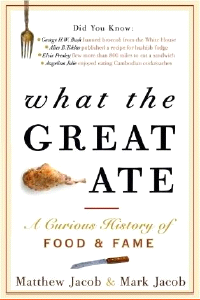Journalists — and brothers — Matthew and Mark Jacob must have had a blast writing What the Great Ate: A Curious History of Food & Fame (Three Rivers 2010).
This book surveys everything culinary that famous people have said or done. If you like books of great quotations –- or even Flip Wilson’s standup on great quotations — this book is full of gems you’ll enjoy.
However, this is no mere collection of food tales:
It is supposed to entertain, but it’s not mere trivia. Eating is a primary instinct. How did it influence the higher accomplishments, such as writing, composing, and theorizing? What food-related obsessions guided humankind’s development? And what is the fuel for genius? (p. ix)
The chapter on writers, “Eating Their Words,” starts with a passage about how Ernest Hemingway’s father made him eat a porcupine when he was thirteen years old after he had killed it because it had injured a dog. (p. 31) The subsequent passage relates to how Sinclair Lewis tried to curb his alcohol intake by concocting a recipe for chocolate cookies that called for a shot of bourbon (p. 32).
 The book’s index is useful for looking up the names of the famous and infamous, but it does not list ingredients or dishes by name.
The book’s index is useful for looking up the names of the famous and infamous, but it does not list ingredients or dishes by name.
There is a fun chapter on the presidents. The Jacobs write that Thomas Jefferson may have been America’s first foodie. Though they mention that his presidential dinners “set new standards for culinary excellence” (p. 111), unfortunately, they do not record what was eaten at any of those dinner. They do mention that Jefferson smuggled two sacks of Piedmont rice back to America – a crime punishable by death. Luckily, the crime was not uncovered, but too bad the South Carolina farmers did not start growing this great rice.
Tuck What the Great Ate into your dining room bookshelf next to your encyclopedias and dictionaries, and you’ll find plenty of reasons to take it down and explore it.

Juliette– I’m Mark Jacob, co-author of “What the Great Ate.” Thanks for your nice comments. You were curious about what Jefferson might have served at dinner. The answer is: an amazing and delicious assortment. He introduced eggplant to the United States, he was planting and eating tomatoes at a time when many Americans feared they were poisonous, and the oldest, surviving American recipe for ice cream was written by Jefferson. He served macaroni at a time when it was considered a strange foreign substance. He enjoyed French food so much that rival Patrick Henry called him “a man unfaithful to his native victuals.” Jefferson was a truly amazing American diner — and not a bad political visionary either. … I wanted to mention that an ever-growing collection of food trivia is available at our website, whatthegreatate.org … Thanks!
The Jacobs’ book What the Great Ate: A Curious History of Food and Fame is packed full of fun food stories. I’m not a foodie, but I quite enjoyed it. In a casual writing style the authors bring together anecdotes from around the world. These are tiny morsels rather than a five course narrative meal, so the book would be perfect for very light beach reading (despite being a little over 250 pages, it only took me a couple of hours to breeze through), or better yet, something for the teenage kids (anecdotes appear in two or three paragraph sections–about one page a piece). Some parents might appreciate its reinforcement of messages about avoiding dangerous behaviors. For example, there is a story about Robert Downey Jr. “kicking his illegal drug habit” after a tragic visit to Burger King.